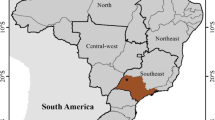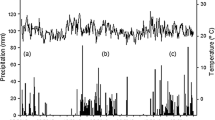Abstract
A field experiment in western Kenya assessed whether the agroforestry species Tithonia diversifolia (Hemsley) A. Gray, Tephrosia vogelii Hook f., Crotalaria grahamiana Wight & Arn. and Sesbania sesban (L) Merill. had access to forms of soil P unavailable to maize, and the consequences of this for sustainable management of biomass transfer. The species were grown in rows at high planting density to ensure the soil under rows was thoroughly permeated by roots. Soil samples taken from beneath rows were compared to controls, which included a bulk soil monolith enclosed by iron sheets within the tithonia plot, continuous maize, and bare fallow plots. Three separate plant biomass samples and soil samples were taken at 6-month intervals, over a period of 18 months. The agroforestry species produced mainly leaf biomass in the first 6 months but stem growth dominated thereafter. Consequently, litterfall was greatest early in the experiment (0–6 months) and declined with continued growth. Soil pH increased by up to 1 unit (from pH 4.85) and available P increased by up to 38% (1 μg P g−1) in agroforestry plots where biomass was conserved on the field. In contrast, in plots where biomass was removed, P availability decreased by up to 15%. Coincident with the declines in litterfall, pH decreased by up to 0.26 pH units, plant available P decreased by between 0.27 and 0.72 μg g−1 and Po concentration decreased by between 8 and 35 μg g−1 in the agroforestry plots. Declines in Po were related to phosphatase activity (R2=0.65, P<0.05), which was greater under agroforestry species (0.40–0.50 nmol MUB s−1 g−1) than maize (0.28 nmol MUB s−1 g−1) or the bare fallow (0.25 nmol MUB s−1 g−1). Management of tithonia for biomass transfer, decreased available soil P by 0.70 μg g−1 and Po by 22.82 μg g−1. In this study, tithonia acquired Po that was unavailable to maize. However, it is apparent that continuous cutting and removal of biomass would lead to rapid depletion of P stored in organic forms.
Similar content being viewed by others
References
Barrios E, Kwesiga F, Buresh R J and Sprent J I 1997 Light fraction soil organic matter and available nitrogen following trees and maize. Soil Sci. Soc. Am. J. 37, 121-131.
Barrow N J 1987 Reactions with Variable Charge Soils. Martinus Nijhoff, Dordrecht.
Bhardwaj K K R and Datt N 1995 Effects of legume green-manuring on nitrogen mineralisation and some microbiological properties in an acid rice soil. Biol. Fertil. Soil. 19, 19-21.
Blair G J and Boland O W 1978 The release of P from plant material added to soil. Aust. J. Soil Res. 16, 101-111.
Buresh R J and Niang A I 1997 Tithonia diversifolia as a green manure: awareness, expectations and realities. Agrofor. Forum 8, 29-31.
Chander K, Goyal S, Nandal D P and Kapoor K K 1998 Soil organic matter, microbial biomass and enzyme activity in a tropical agroforestry system. Biol. Fertil. Soil 27, 168-172.
Gachengo C N, Palm C A, Jama B and Othieno C 1999 Tithonia and senna green manures and inorganic fertilizers as phosphorus sources for maize in western Kenya. Agrofor. Systems 44, 21-36.
George T S, Gregory P J, Robinson J S, Buresh R J and Jama B 2001 Tithonia diversifolia: Variations in leaf nutrient concentration and implications for biomass transfer. Agrofor. Syst. 52, 199-205.
George T S, Gregory P J, Robinson J S and Buresh R J 2002a Changes in phosphorus concentrations and pH in the rhizosphere of some agroforestry and crop species. Plant Soil (in press).
George T S, Gregory P J, Robinson J S, Wood M, Read D and Buresh R J 2002b Phosphorus active root exudates in the rhizosphere of Tithonia diversifolia and other potential agroforestry species. Soil Biol. Biochem. (in press).
Haggar J P and Ewel J J 1994 Experiments on the ecological basis of sustainability: early findings on nitrogen, phosphorus and root systems. Interciencia 19, 347-351.
Hedley M J, Kirk G J D and Santos M B 1994 Phosphorus efficiency and the forms of soil phosphorus utilised by upland rice cultivars. Plant Soil 158, 53-62.
Jama B, Swinkels R A and Buresh R J 1997 Agronomic and economic evaluation of organic and inorganic sources of phosphorus in western Kenya. Agron. J. 89, 597-604.
Jama B, Buresh R J and Place F M 1998 Sesbania tree fallows on phosphorus deficient sites: Maize yield and financial benefit. Agron. J. 90, 717-726.
Jama B, Palm C A, Buresh R J, Niang A, Gachengo C, Nzinguheba G and Amadalo B 2000 Tithonia diversifolia as a green manure for soil fertility improvement in western Kenya: a review. Agrofor. Syst. 49, 201-221.
Kang B T, Caveness F E, Tian G and Kolawole G O 1999 Longterm alley cropping with four hedgerow species on an Alfisol in southwestern Nigeria: effects on crop performance, soil chemical properties and nematode population. Nutr. Cycl. Agroecosyst. 54, 145-155.
Khanna P K 1997 Nutrient cycling under mixed-species tree systems in southeast Asia. Agrofor. Syst. 38, 99-120.
Maroko J B, Buresh R J and Smithson P C 1999 Soil phosphorus fractions in unfertilised fallow-maize systems in two tropical soils. Soil Sci. Soc. Am. J. 63, 320-326.
Marx M-C, Wood M and Jarvis S C 2001 A microplate fluorimetric assay for the study of enzyme diversity in soils. Soil Biol. Biochem. 33, 1633-1640.
McGrath D A, Comerford N B and Duryea M L 2000 Litter dynamics and monthly fluctuations in soil phosphorus availability in an Amazonian agroforest. For. Ecol. Manage. 131, 167-181.
Murphy J and Riley J P 1962 A modified single solution method for the determination of phosphate in natural waters. Anal. Chim. Acta 27, 31-36.
Mutuo P K, Smithson P C, Buresh R J and Okalebo R J 1999 Comparisons of phosphate rock and triple superphosphate on a phosphorus deficient Kenyan soil. Commun. Soil Sci. Plant Anal. 30, 1091-1103.
Ndufa J K, Sheppard K D, Buresh R J and Jama B 1999 Nutrient uptake and growth of young trees in a P-deficient soil: tree species and phosphorus effects. For. Ecol. Manage. 122, 231-241.
Niang A, Amadalo B, Gathumbi S and Obonyo C O 1996 Maize yield response to green manure application from selected shrubs and tree species in western Kenya: a preliminary assessment. East Afr. Agric. For. J. 62, 199-207.
Nyathi P and Campbell B 1994 Leaf quality of Sesbania sesban, Leucaena leucocephala and Brachystegia spiciformis: potential of agroforestry species. For. Ecol. Manage. 64, 259-264.
Nyberg G and Hogberg P 1995 Effects of young agroforestry trees on soils in on-farm situations in western Kenya. Agrofor. Syst. 32, 45-52.
Onim J F M, Mathuva M, Otieno K and Fitzhugh H A 1990 Soil fertility changes and response of maize and beans to green manures of leucaena, sesbania and pigeonpea. Agrofor. Syst. 12, 197-215.
Palm C A, Nziguheba G, Gachengo C, Gacheru E and Rao M R 1999 Organic materials as sources of phosphorus. Agrofor. Forum 9, 30-33.
Palm C A 1995 Contribution of agroforestry trees to nutrient requirements of intercropped plants. Agrofor. Syst. 30, 105-124.
Parkinson J A and Allen S E 1975 A wet oxidation procedure suitable for the determination of nitrogen and mineral nutrients in biological materials. Commun. Soil Sci. Plant Anal. 6, 1-11.
Rao M R, Niang A, Kwesiga F, Duguma B, Franzel S, Jama B and Buresh R 1998 Soil fertility replenishment in sub-Saharan Africa: new techniques and the spread of their use on farms. Agrofor. Today 10, 3-8.
Wick B, Kuhne R F and Vlek P L G 1998 Soil microbiological parameters as indicators of soil quality under improved fallow management systems in south-western Nigeria. Plant Soil 202, 97-107.
Author information
Authors and Affiliations
Corresponding author
Rights and permissions
About this article
Cite this article
George, T., Gregory, P., Robinson, J. et al. Utilisation of soil organic P by agroforestry and crop species in the field, western Kenya. Plant and Soil 246, 53–63 (2002). https://doi.org/10.1023/A:1021575532546
Issue Date:
DOI: https://doi.org/10.1023/A:1021575532546




